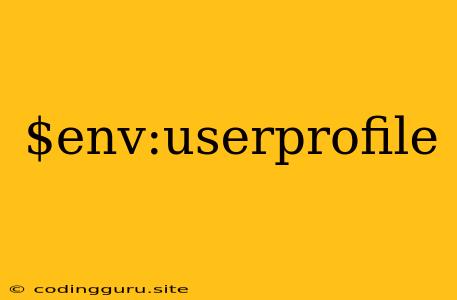Exploring the Power of $env:userprofile
The environment variable $env:userprofile is a powerful tool in Windows PowerShell, providing a convenient way to access the current user's profile directory. This variable plays a crucial role in various tasks, from customizing your workspace to automating repetitive processes. But how exactly does it work, and what are its practical applications?
Understanding the Basics
$env:userprofile is a special variable that holds the path to the directory where your user profile settings are stored. It essentially points to your "home" folder within the Windows operating system. For instance, on a typical Windows 10 system, the value of $env:userprofile might be something like:
C:\Users\YourUserName
This means that all your personalized settings, including documents, downloads, desktop icons, and application data, reside within this directory.
Why is it Important?
Understanding and utilizing $env:userprofile offers several advantages:
- Streamlined Scripting: When writing PowerShell scripts, you can easily reference this variable to access user-specific files and folders without manually typing out the entire path.
- Enhanced Portability: Scripts that rely on
$env:userprofileare more portable since they can dynamically adapt to different user environments. - Simplified Automation: Automating tasks like backing up files or creating shortcuts becomes much easier with the help of
$env:userprofile.
Practical Applications
Let's explore some practical examples of how $env:userprofile can be used:
1. Accessing User Files
To access a specific file in the user's documents folder, you can use the following:
$userDocs = Join-Path -Path $env:userprofile -ChildPath Documents
Get-ChildItem -Path $userDocs
This code first combines the user's profile path with the "Documents" subfolder, then retrieves a list of files within that directory.
2. Creating Shortcuts
You can use $env:userprofile to create shortcuts for commonly used applications on the desktop. For example:
$desktop = Join-Path -Path $env:userprofile -ChildPath Desktop
New-Item -ItemType SymbolicLink -Path $desktop\Notepad.lnk -Target "C:\Windows\System32\notepad.exe"
This creates a shortcut named "Notepad.lnk" on the desktop, pointing to the Notepad application.
3. Customizing the Environment
You can dynamically modify your user environment based on the value of $env:userprofile. This allows for personalized configurations for different users.
Example:
if ($env:userprofile -eq "C:\Users\Admin") {
# Set a specific environment variable for the Admin user
$env:MyCustomVar = "AdminValue"
} else {
# Set a different environment variable for other users
$env:MyCustomVar = "DefaultValue"
}
Conclusion
$env:userprofile is an indispensable tool for Windows PowerShell scripting and automation. It provides a convenient way to access user-specific files, folders, and settings, allowing for greater flexibility, customization, and portability in your scripts. By understanding the power of $env:userprofile, you can significantly enhance your PowerShell capabilities and streamline your workflow.
